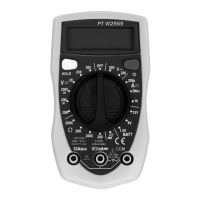13
Fig. 12
leads across diode and view
display.
Display will show one of three
things:
• A typical voltage drop of
around 0.7V.
• A voltage drop of 0 volts.
• A “1” will appear indicating the
multimeter is overranged.
7. Switch RED and BLACK test
leads and repeat Step 6.
8. Test Results
If the display showed:
• A voltage drop of 0 volts in
both directions, then the diode
is shorted and needs to be
replaced.
• A “1” appears in both direc-
tions, then the diode is an open
circuit and needs to be re-
placed.
• The di
ode is good if the dis-
play reads around 0.5V–0.7V
in one direction and a “1” ap-
pears in the other direction
indicating the multimeter is
overranged.
Testing Diodes
A diode is an electrical component
that allows current to only flow in one
direction. When a positive voltage,
generally greater than 0.7V, is ap-
plied to the anode of a diode, the
diode will turn on and allow current to
flow. If this same voltage is applied to
the cathode, the diode would remain
off and no current would flow. There-
fore, in order to test a diode, you must
check it in both directions (i.e. anode-
to-cathode, and cathode-to-anode).
Diodes are typically found in alterna-
tors on automobiles.
Performing Diode Test (see Fig. 12):
Anode
Cathode
Black
Red
1. Insert BLACK test lead into
COM test lead jack.
2. Insert RED test lead into
test lead jack.
3. Turn multimeter rotary switch
to
function.
4. Touch RED and BLACK test
leads together to test continu-
ity.
Check display – should reset to
0.00.
5. Disconnect one end of diode
from circuit.
Diode must be totally isolated
from circuit in order to test its
functionality.
6. Connect RED and BLACK test
4. Connect RED test lead to one
side of disconnected circuit.
5. Connect BLACK test lead to
remaining side of discon-
nected circuit.
6. Turn multimeter rotary switch
to 10A DC position, 200mA or
200
µA position.
7. View reading on display.
If minus (-) sign appears on dis-
play, then reverse RED and
BLACK test leads.

